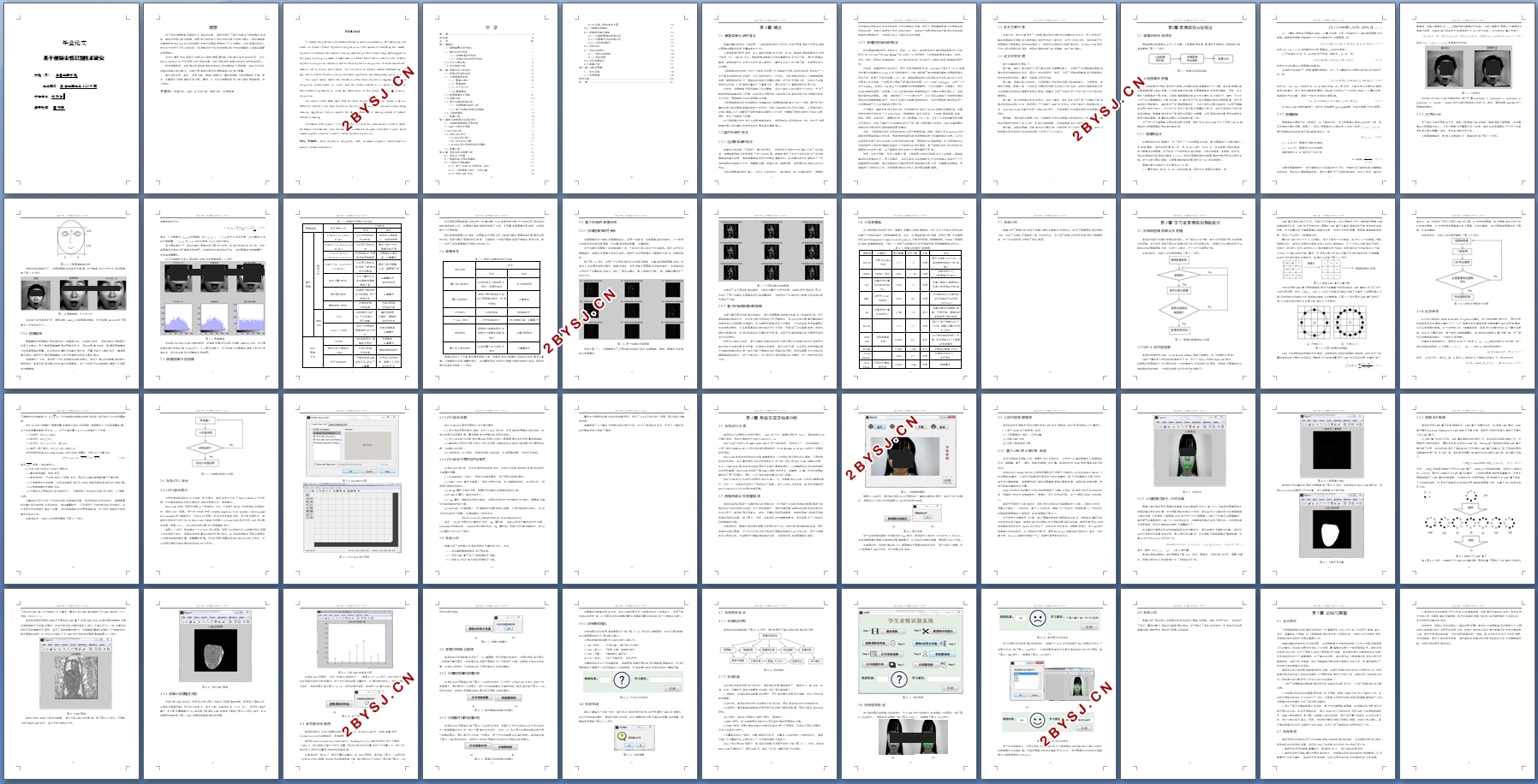基于视频表情识别技术研究
无需注册登录,支付后按照提示操作即可获取该资料.
基于视频表情识别技术研究(任务书,开题报告,外文翻译,论文16000字)
摘要
为了弥补远程教育中情感交互存在的问题,本研究提出了基于视频的人脸表情识别系统,捕捉识别学习者的表情,判断学习者的学习状态并给出相应的学习建议。本文借助商业数学软件MATLAB对短视频中的学生的面部表情进行了识别模拟,并对表情识别的几种主流方法进行了探讨和比较,所得结论对于加深对表情识别技术的理解和应用具有重要的指导意义。
论文主要研究的是基于视频的人脸表情图像获取及表情识别系统的实现,并于MATLAB R2012a平台界面上进行系统仿真,验证系统实现表情识别的有效性和实用性。
研究结果表明:该表情识别系统能够较有效的识别视频中的人脸表情,并给出可视化的结论和相应学习建议,有助于提高学生通过远程教育学习的学习质量。
本文的特点是:首先,选用LBP(局部二值模式)算法来提取人脸的面部特征值。然后,计算得出人脸轮廓特征直方图。最后,k近邻分类器被用来分类人像的面部表情,进行判别。
关键词:表情识别;LBP;K近邻分类;情感分析;远程教育
Abstract
To remedy the problem in the distance education emotional interaction, this study proposed based on system of facial expression recognition in video capture of identifying the learners' expression to determine the learner's learning state and give the corresponding study suggest. In this paper, by using a commercial mathematical software MATLAB on a short video of facial expression recognition simulation, and for facial expression recognition of several mainstream method was to explore and compare. The conclusions to enhance mutual understanding and application of facial expression recognition technology has an important guiding significance.
This paper mainly studies the realization of the facial expression imageacquisition and recognition system based on video, and the system simulation is carried out on the MATLABR2012aplatform to verify the effectiveness of the system for facial expression recognition.
The results of the study show that: the facial expression recognition system is able to effectively identify video facial expression, the conclusion and give visual and corresponding learning suggestions, help to improve the students through the learning quality of distance education learning.
The feature of this paper is: First of all, the LBP (local two value model) is used to extract the feature of human face. Then, the face contour feature histogram is calculated. Finally, the K nearest neighbor classifier is used to classify the facial expressions.
Key Words:facial expression recognition; LBP; K nearest neighbor classifier;emotion analysis; Distance Education

目 录
摘 要 I
Abstract II
目 录 III
第1章绪论 1
1.1课题背景及研究意义 1
1.2国内外研究现状 1
1.2.1远程教育研究现状 1
1.2.2 表情识别技术研究现状 2
1.3论文主要内容 3
1.4论文结构安排 3
第2章 表情识别方法综述 4
2.1表情识别系统综述 4
2.2人脸图像预处理 4
2.2.1图像灰度化 4
2.2.2图像旋转 5
2.2.3尺寸归一化 6
2.2.4图像增强 7
2.3表情图像特征提取 8
2.4表情分类 10
2.5基于视频的表情识别 11
2.5.1视频图像关联性分析 11
2.5.2基于视频的表情识别策略 12
2.6人脸表情库 13
2.7本章小结 14
第3章学习者表情识别系统设计 15
3.1视频帧图像提取及预处理 15
3.2LBP人脸特征提取 15
3.3K近邻分类 17
3.4系统GUI设计 19
3.4.1GUI设计简介 19
3.4.2 GUI设计步骤 21
3.4.3GUI设计中常用组件及属性 21
3.5本章小结 21
第4章 系统实现及结果分析 23
4.1系统运行环境 23
4.2图像获取及预处理模块 23
4.3人脸特征提取模块 25
4.3.1基于ASM的人脸检测、标志 25
4.3.2 人脸图像二值化、凸壳运算 26
4.3.3获取LBP矩阵 28
4.3.4获取人脸纹理直方图 30
4.4分类器训练模块 31
4.5表情判别输出模块 32
4.5.1对单帧图像的表情识别 32
4.5.2对图像序列的表情识别 32
4.5.3识别测试输出 33
4.6系统关闭 33
4.7系统总体设计 34
4.7.1系统总体结构 34
4.7.2系统界面 34
4.8识别效果验证 35
4.9本章小结 37
第5章 总结与展望 38
5.1全文总结 38
5.2发展展望 38
参考文献 40
致 谢 41
